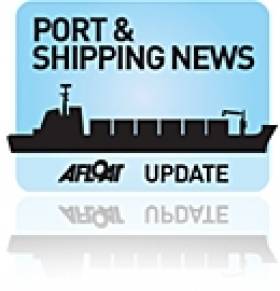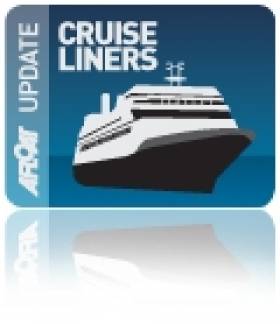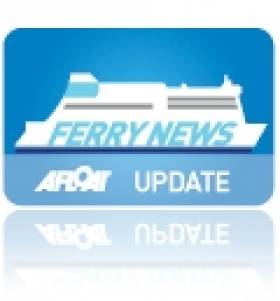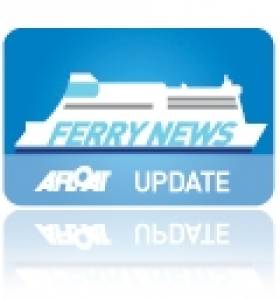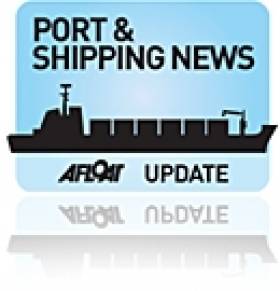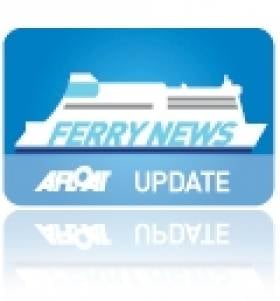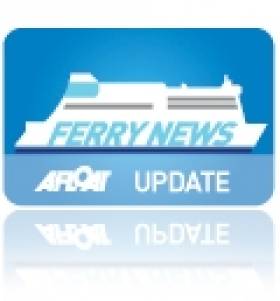Displaying items by tag: Rosslare Europort
Rosslare Europort To Dredge Sand Build-Up from Storms
#portsandshipping – Dredging at the breakwater of Rosslare Europort of sand which built up in the storms of January and February this year is to begin during week commencing 30th November.
The movement of sand which took place along the breakwater over two weeks of severe storms in late January and early February 2014 was estimated up to 100,000 m3, unprecedented given the typical annual average levels of 11,000m3. As a result, Berth 4 has been out of use since then, and there have also been some navigation restrictions.
Iarnród Éireann, the Port Authority for Rosslare Europort, applied for and has now received a foreshore licence and a dredging licence to proceed with the dredging works to restore the Europort to normal working conditions.
The sand removed from the Europort by its contractor will be placed just outside low water at Rosslare Strand, and it is expected to be carried up onto the beach there to replenish it. This is a repetition of the strategy successfully followed at the last dredging in 2011, and follows consultation with the Environmental Protection Agency and the Department of the Environment and licence approval.
Iarnród Éireann has allocated funding of €1.4m for this project, and the dredging work is expected to take approximately three weeks. Normal port operations will continue throughout these works.
Export Industry Awards Winners Announced
#ExporterAwards – The Irish Exporters Association (IEA) annual Export Industry Awards gala dinner evening which attracted 500 guests was held recently in the National Convention Centre Dublin.
Minister for Communications, Energy & Natural Resources, Alex White, provided a keynote address to Ambassadors and Dignitaries from 24 Embassies in Ireland, while Ivan Yates presided as master of ceremonies.
Aerogen, a medical device and drug delivery company based in Dangan, Co. Galway, won the coveted Exporter of the Year 2014 award presented by hosts, IEA in association with sponsor HSBC. Aerogen also took home the Life Sciences Exporter of the Year Award.
The awards now in their 14th year included the category Medium Size Exporter of the Year which went to Athlone Extrusions with the category sponsored by Rosslare Europort.
The Awards recognise the achievements of companies working in the export industry. In total there are 11 companies which won individual category awards across a range of sectors.
To find out the names of the other award winners and more click HERE.
First Cruise Caller for More than 20 Years to visit Rosslare Europort
#Cruise&FerryRosslare – Phoenix Reisen's Albratros is to become the first cruiseship caller in more than two decades to visit Rosslare Europort, when she visits in August 2015 bringing new tourists to the south east region.
According to Iarnród Éireann who are the port authority of the ferryport, they say that the cruise ship will call at Rosslare as part of a cruise of Ireland and Britain, which begins from Bremerhaven, Germany.
Other destinations include those in Scotland, Belfast Northern Ireland, the south coast of England and Amsterdam.
A Working Group led by the General Manager Rosslare Europort John Lynch, including representatives of Wexford County Council and Fáilte Ireland and supported by Visit Wexford, have been working on developing the cruise business at Rosslare.
It is hoped that this will be the first of many cruises that will call at the port.
Albatros has a capacity for 850 guests, the majority of whom will be German. The vessel will anchor off Rosslare Harbour with tenders bringing guests ashore.
Attractions that may be part of the land excursion possibly include: the Irish National Heritage Park, the Hook Head Peninsula, the Emigrants' Trail, Wells House & Garden, Wexford Town Walking Tour including the Opera House and many other amenities.
General Manager of Rosslare Europort John Lynch said: "We are delighted to welcome the MS Albatros to Rosslare next year. We are fortunate at Rosslare that not only do we have the capacity to operate as a busy commercial port, but we are also situated in an area of outstanding natural beauty and rich cultural heritage and I believe that there will be many more Cruise Ships that will want to explore the wonders of Wexford and the South East."
Continental Rosslare Routes Ro-Pax Rivals Meet for First Time
#IrelandFranceSpain – Newcomer LD Lines ro-pax Scintu, to be renamed Norman Atlantic, met one of her rivals operating on continental routes when Irish Ferries Cartour Epsilon docked in Rosslare Europort yesterday, writes Jehan Ashmore.
As previously reported, LD Lines inaugural inbound sailing from France to Ireland took place with a Thursday night arrival at the Wexford port. The 26,904 tonnes ferry remained in port overnight and for much of yesterday prior to setting sail last night on the first outward sailing of the Rosslare-St.Nazaire-Gijón service.
The first leg of the Ireland-France-Spain service sees Scintu scheduled to arrive in St.Nazaire at 19.00hrs this evening.
Irish Ferries ro-pax Cartour Epsilon which initially entered service on the Dublin-Holyhead route just before the busy festive season saw the ferry only make a handful of sailings due to the low level of sailings assigned to the newcomer.
In addition a spate of bad weather led to cancelled sailings of the Cartour Epsilon including fast-craft Jonathan Swift sailings, leaving flagship Ulysses on occasions to operate crossings alone.
As also reported on Afloat.ie, Irish Ferries are to operate the 2011 Visentini shipyard built Cartour Epsilon (same design of Scintu, built 2009) on Dublin-Holyhead route in addition on the new Dublin-Cherbourg route starting this day next week (18 January).
In the meantime Cartour Epsilon is currently providing relief cover on the Rosslare-Cherbourg route in place of cruiseferry Oscar Wilde which transferred to sailings between Rosslare-Pembroke Dock.
Oscar Wilde displaced the Welsh route ferry Isle of Inishmore which in turn took over the sailing roster of Cartour Epsilon on the Dublin-Holyhead route also during the run up to the festive period.
Rival ro-pax continental ferries, Scintu (on left) berthed adjacent to Cartour Epsilon yesterday at Rosslare Europort. Photo: Jehan Ashmore
Isle of Inishmore subsequently took over the sailing roster of Ulysses which is undergoing annual maintenance at Cammell Laird, Birkenhead. In the meantime partnering Isle of Inishmore on the Dublin-Holyhead route is the fast-ferry Jonathan Swift.
#Rail&Sail – Irish Rail have amendment the Rosslare Europort-Dublin railway service so to provide 'greater connectivity' for ferry passengers, albeit the new schedule was only introduced for this year of The Gathering, writes Jehan Ashmore.
The National Transport Authority approved the amended rail timetable which started this month and remains valid until 2 September.
The changes are to improve certain connection times between ferries arriving in the Wexford port and passengers making onward rail journeys to the capital and beyond.
Special Gathering travel tickets have been introduced by Irish Rail and Bus Éireann to give ticket holders unlimited travel across both companies' extensive networks for either three days or seven days.
Below are the changes made to the Rosslare Europort-Dublin (Connolly Station) service schedule.
- The 17:55 Rosslare Europort to Connolly will be deferred until 19:15 Monday to Saturday.
- The 17:36 Connolly to Wexford service will depart at usual time but there will be an extended journey time between Enniscorthy and Wexford with an arrival time of 20:25 into Wexford Monday to Friday.
- On Sundays the 17.40 Rosslare Europort to Connolly will be deferred to 19:00.
Rosslare Europort is unique in that the harbour is operated by the state owned transport company and from where three ferry operators run routes to Wales and France, including the seasonal-only Roscoff route which resumed recently.
Sail to Ireland with Celtic Link for Next to Nothing!
#FERRY NEWS - Celtic Link Ferries have announced their best ever ferry deal between France and Ireland to coincide with The Gathering 2013.
On Friday 15 March 2013 - in time for the St Patrick's Weekend festivities - all vehicles will sail from Cherbourg to Rosslare Europort for just €1 each.
The fantastic deal is inclusive of a vehicle, cabin and the people in the cabin - but act fast, as this 'next to nothing' offer is available for this one day only.
“Celtic Link Ferries are simply bringing in as many passengers as they can - for as little price that they can,” says passenger manager Rory McCall.
Bookings for this day can be made at www.celticlinkferries.com.
Review of Rosslare Could Lead to Change of Ownership
#ROSSLARE - The Department of Transport has tendered for external consultants to carry out a strategic review of Rosslare Europort, the Co. Wexford harbour which is predominantly a ferryport is currently operated by Irish Rail, the Irish Times reports.
The advisers will be asked to review the port's current commercial and operational efficiency and advise on an appropriate ownership structure.
This could include local authority involvement or some form of privatisation. It is understood the Government would prefer to retain Rosslare in state ownership, given its importance to tourism and trade.
A Celtic Link Voyage to The Gathering 2013
#FERRY NEWS – Celtic Link Ferries are to participant in Ireland's The Gathering 2013, a year-long initiative to celebrate all things Irish, with a unique opportunity to take a car from France on their Cherbourg-Rosslare service for free, writes Jehan Ashmore.
The special offer is limited to the sailing scheduled to depart Cherbourg on 15th March, with an arrival the next day to Rosslare Europort, in advance of the nation's annual celebrations on St. Patrick's Day.
Those travelling on this sailing will have the chance to sample the Celtic Horizon, the newest and fastest ship sailing on this route between Normandy and Wexford.
Among the facilities on board the 27,522 tonnes vessel is the forward facing restaurant, the Cherbourg Café Lounge and adjoining children's playroom, cinema and Wi-Fi. Accommodation is provided in 110 cabins and vehicle decks for 200 cars and up to 120 freight trucks.
For further details of The Gathering voyage and other offers visit: www.celticlinkferries.com
Ferry Firm and Port Reach Deal Over Fees
#FERRY NEWS – Celtic Link Ferries which operates on the Rosslare-Cherbourg route has reached an agreement with Rosslare Europort, to end a stalemate in over €100,000 relating to port landing fees. It comes after the port company recently lodged a petition in court to wind up the company over alleged unpaid bills.
The O'Flaherty brothers who own Celtic Link along with partner O'Leary International Transport Company said that the ferry firm were being overcharged in comparison with competitors Stena Line and Irish Ferries and other ports around the country.
Rosslare Europort had been demanding a landing fee of €14.92 for cars and €48 for freight vehicles, however for some time Celtic Link Ferries have been paying €3 for cars and €35 for freight vehicles, as they believed that this was approximately what their competitors were paying.
For more on this story as reported in last week's edition of the Wexford People click HERE.
Celtic Horizon Officially Enters Service
She replaces the Norman Voyager which too was built by Visentini. The 186m ro-pax vessel last week arrived from the Mediterranean (to read more click HERE) and will be chartered to CLF for a five-year term contract. Overall she has a larger passenger deck compared to her predecessor, with a restaurant, two bars, pull-man lounges, a cinema, children's play-area, game-zone and kiosk-shop.
In addition to her 130 cabins she has five vehicle decks for 200 cars and a total 2,500 lane freight metres equating to around 110-trucks. An unusual feature is an escalator that whisks passengers from the car-decks up to the passenger deck.
Prior to the event, Celtic Horizon had arrived into the Wexford port. She had completed her maiden 'Irish' round-trip commercial voyage over the weekend from Cherbourg during stormy seas under the command of Captain Richard Collins.
Last year CLF handled 60,000 passengers and 50,000 vehicles between tourist vehicles and freight business. This year they are expecting an increase of passenger traffic of around 30%. The company are the only ferry operator running year-round sailings on the Irish –French routes.
CLF took over the Rosslare-Cherbourg route from P&O in 2005. With the Celtic Horizon they will continue providing three-round trips per week on the route which transports passengers, tourist cars, camper-vans, freight trucks including livestock and the importation of French manufactured new trade-cars.


























